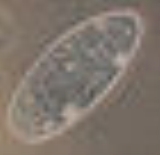
Peniculid
Encyclopedia
The peniculids are an order of ciliate
protozoa, including the well-known Paramecium
and its close relatives. Most are relatively large, freshwater forms that feed on smaller organisms swept into the mouth. They have simple life cycles, and in many cases do not even form resting cysts.
Typically the body has uniform, dense cilia, which also cover a vestibule preceding the mouth. Extrusome
s are characteristically in the form of spindle trichocysts, which release thread-like shafts, and never mucocysts. The oral cilia include peniculi, corresponding to the membranelle
s of related groups, arranged parallel to the mouth deep in the oral cavity. Nematodesmata (rods) arise from the bases of the oral or perioral cilia, but these do not support a cyrtos as in some other classes. Two suborders are recognised:
The peniculids were first defined by Fauré-Fremiet in 1956. Originally they were one of three suborders of the hymenostome
s, which are now treated as subclasses of the Oligohymenophorea
. They were divided into two suborders by Small and Lynn in 1985, who placed them in the class Nassophorea
, owing to ultrastructural peculiarities such as the presence of nematodesmata, which was considered to indicate the cyrtos was secondarily absent. However, more recent schemes reverse this move.
Ciliate
The ciliates are a group of protozoans characterized by the presence of hair-like organelles called cilia, which are identical in structure to flagella but typically shorter and present in much larger numbers with a different undulating pattern than flagella...
protozoa, including the well-known Paramecium
Paramecium
Paramecium is a group of unicellular ciliate protozoa, which are commonly studied as a representative of the ciliate group, and range from about 0.05 to 0.35 mm in length. Simple cilia cover the body, which allow the cell to move with a synchronous motion at speeds of approximately 12 body...
and its close relatives. Most are relatively large, freshwater forms that feed on smaller organisms swept into the mouth. They have simple life cycles, and in many cases do not even form resting cysts.
Typically the body has uniform, dense cilia, which also cover a vestibule preceding the mouth. Extrusome
Extrusome
Extrusomes are membrane-bound structures in some eukaryotes which, under certain conditions, discharge their contents outside the cell. There are a variety of different types, probably not homologous, and serving various functions....
s are characteristically in the form of spindle trichocysts, which release thread-like shafts, and never mucocysts. The oral cilia include peniculi, corresponding to the membranelle
Membranelle
Membranelles are structures found around the mouth, or cytostome, in ciliate protists. They are typically arranged in series, to form an "adoral zone of membranelles," or AZM, on the left side of the buccal cavity . The membranelles are made up of kinetosomes arranged in groups to make up...
s of related groups, arranged parallel to the mouth deep in the oral cavity. Nematodesmata (rods) arise from the bases of the oral or perioral cilia, but these do not support a cyrtos as in some other classes. Two suborders are recognised:
- The Frontoniina typically have a shallow oral cavity, with a long paroral membrane and denser somatic kineties to the right of the mouth. These are called ophryokineties, and take part in forming the new mouth during cell division.
- The Parameciina typically have a deeper oral cavity, with peniculi mainly forward of the mouth, and the paroral membrane reduced, though still present throughout interphase.
The peniculids were first defined by Fauré-Fremiet in 1956. Originally they were one of three suborders of the hymenostome
Hymenostome
The hymenostomes are an order of ciliate protozoa. Most are free-living in freshwater, such as the commonly studied genus Tetrahymena, but some are parasitic on fish or aquatic invertebrates. Among these is the important species Ichthyopthirius multifiliis, a common cause of death in aquaria and...
s, which are now treated as subclasses of the Oligohymenophorea
Oligohymenophorea
The Oligohymenophorea are a large class of ciliate protozoa. There is typically a ventral groove containing the mouth and distinct oral cilia, separate from those of the body. These include a paroral membrane to the right of the mouth and membranelles, usually three in number, to its left. The...
. They were divided into two suborders by Small and Lynn in 1985, who placed them in the class Nassophorea
Nassophorea
The Nassophorea are a class of ciliate protozoa. Members are free-living, usually in freshwater but also in marine and soil environments. The mouth is anterior ventral and leads to a curved cytopharynx supported by a prominent palisade of rods or nematodesmata, forming a structure called a cyrtos...
, owing to ultrastructural peculiarities such as the presence of nematodesmata, which was considered to indicate the cyrtos was secondarily absent. However, more recent schemes reverse this move.

